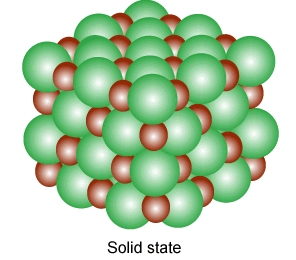The distance between \(Na^+\) and \(Cl^–\) ions in solid \(NaCl\) of density \(43.1\ g\ cm^{–3}\) is ____ \(× 10^{–10}\ m\). (Nearest Integer)
(Given : \(N_A = 6.02 × 10^{23} mol^{–1}\))
(Given : \(N_A = 6.02 × 10^{23} mol^{–1}\))
Correct Answer: 1
Solution and Explanation
\(ρ = \frac {Z\times M}{a^3\times N_A}\)
\(43.1 = \frac {4×58.5}{a^3×6.02×10^{23}}\)
\(a^3 = \frac {4×58.5}{43.1×6.02×10^{23}}\)
\(a^3 = 0.9 × 10^{–23}\)
\(a^3= 9 × 10^{–24}\)
\(a = 2.08 × 10^{–8} cm\)
\(a= 2.08 × 10^{–10} m\)
for \(NaCl\), distance between \(Na^+\) and \(Cl^–\) = \(\frac a2\)
\(= \frac {2.04 × 10^{–10}}{2} m\)
\(= 1.02 \times 10^{–10} m\)
So, the answer is \(1\).
Top Questions on The solid state
- A metal crystallizes in simple cubic lattice. The volume of one unit cell is \( 6.4 \times 10^{-7} \, \text{pm}^3 \). What is the radius of the metal atom in pm?
- AP EAPCET - 2025
- Chemistry
- The solid state
- A metal crystallises in two cubic phases, fcc and bcc with edge lengths 3.5 Å and 3 Å respectively. The ratio of densities of fcc and bcc is approximately
- TS EAMCET - 2025
- Chemistry
- The solid state
- How many kinds of Bravais lattice are possible in a crystal?
- Bihar Board XII - 2025
- Chemistry
- The solid state
- The percentage of free space in a body-centred cubic unit cell is
- Bihar Board XII - 2025
- Chemistry
- The solid state
- The number of atoms present in body-centred cubic unit cell is
- Bihar Board XII - 2025
- Chemistry
- The solid state
Questions Asked in JEE Main exam
- Let \( A = [a_{ij}] \) be a matrix of order 3 \(\times\) 3, with \(a_{ij} = (\sqrt{2})^{i+j}\). If the sum of all the elements in the third row of \( A^2 \) is \( \alpha + \beta\sqrt{2} \), where \(\alpha, \beta \in \mathbb{Z}\), then \(\alpha + \beta\) is equal to:
- JEE Main - 2025
- Matrices and Determinants
Consider the following sequence of reactions :

Molar mass of the product formed (A) is ______ g mol\(^{-1}\).- JEE Main - 2025
- Organic Chemistry
The magnitude of heat exchanged by a system for the given cyclic process ABC (as shown in the figure) is (in SI units):

- JEE Main - 2025
- Electric charges and fields
- The value of \( (\sin 70^\circ)(\cot 10^\circ \cot 70^\circ - 1) \) is:
- JEE Main - 2025
- Trigonometric Identities
- The number of 6-letter words, with or without meaning, that can be formed using the letters of the word "MATHS" such that any letter that appears in the word must appear at least twice is:
- JEE Main - 2025
- Calculus
Concepts Used:
Solid State
Solids are substances that are featured by a definite shape, volume, and high density. In the solid-state, the composed particles are arranged in several manners. Solid-state, in simple terms, means "no moving parts." Thus solid-state electronic devices are the ones inclusive of solid components that don’t change their position. Solid is a state of matter where the composed particles are arranged close to each other. The composed particles can be either atoms, molecules, or ions.

Types of Solids:
Based on the nature of the order that is present in the arrangement of their constituent particles solids can be divided into two types;
- Amorphous solids behave the same as super cool liquids due to the arrangement of constituent particles in short-range order. They are isotropic and have a broad melting point (range is about greater than 5°C).
- Crystalline solids have a fixed shape and the constituent particles are arranged in a long-range order.